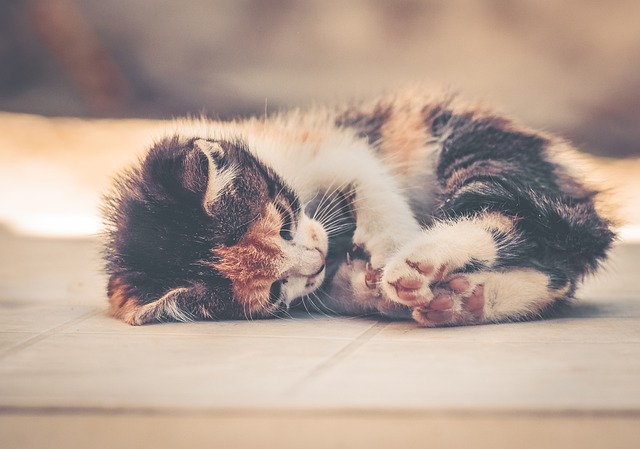As cats, like all pets, cannot talk or express emotions as we do, it can be hard to tell how they are feeling. This is particularly troublesome if they are unwell. Unlike humans, you cannot check their foreheads or neck to see if their temperature is higher than usual as the fur usually gets in the way.
What can you do then? How do you tell if a cat has a fever? In this article, I’ll discuss some behaviors to look out for when checking if your feline has a fever, symptoms you’ll observe when your cat does not feel well, possible causes, and what to do about a feverish kitty.
Table of Contents
What a High Temperature Means in Cats
A cat's normal body temperature ranges between 38 – 39 c. Above this, your cat may feel unwell and possibly lethargic. Even with the fur present, areas such as your cat's feet, ears, or face may feel warmer than usual. Below, I'll outline some of the possible causes of feline fever to help you understand why your cat may "suddenly" start feeling unwell or have an unusually high temperature.
It is important to remember, though, that these are just possible reasons, and your cat's fever isn't likely to be because of anything serious. Don't panic if your cat has a high temperature, as it usually resolves itself without help, just like in humans.
Pyrexia of Unknown Origin (Puo)
Pyrexia of unknown origin, like the name suggests, refers to a condition whereby your cat has a high temperature with no known or apparent cause. Because its root cause is initially unknown, it can be hard to treat and often requires several tests before diagnosis and proper treatment. However, while the cause remains unknown, the cat often feels better after some treatment, care, and lifestyle changes if recommended by a professional.
Pain and Inflammation
Sudden pain from conditions such as arthritis, injuries, and bladder inflammations can cause a rise in your feline’s temperature. These are generally some of the most common causes of fever in felines.
Infections and Abscesses
Infections and abscesses are common fever causes. This is often because the immune system is usually working at full force to fight off the foreign bodies.
Poisoning
Poisoning is another common reason your cat may experience a fever. If your cat has had access to and ingested an insecticide, it could cause muscle tremors which would, in turn, cause your cat to overheat.
Heatstroke
Left in hot areas such as your car, your cat can get a fever. As you'd expect this happens more in summer and often leads to heat stroke which is dangerous.
Obesity
Generally, the more body fat, the more difficult it can be for your cat to lose body heat. If you own an obese feline, it may explain why he seems to stay hot for longer than what is considered normal.
Stress
Our felines, just like their humans, can suffer from stress. This can increase their body temperature and may remain that way until the stressors are removed, and your cat calms down.
Reaction to Medications
Some medications may have increased temperature listed as a side effect. If your feline recently got put on a prescription, it could be the cause of the fever.
Cancer/Tumors
While not a common reason, cancers can cause an elevated temperature in your cat, among other symptoms. Luckily, some common cancers such as the feline leukemia virus (FeLV) can be prevented with vaccination.
How to Tell If Your Feline Has a Fever
You have to start by knowing the normal temperature range of felines. While cats cannot tell us how and what they feel, you can pick up clues from their behaviors. Observation is vital, and it’s straightforward if you’re in tune with your feline’s usual behaviors.
However, note that because cats are usually timid and try to hide away from you, you need to be observant to notice anything amiss.
Common Fever Symptoms in Cats
Cats will show certain signs such as lethargy, appetite loss, and shivering when they are unwell. These are general signs. There are however other symptoms that may specifically point to a fever and they are:
- Dehydration
- Panting
- Behavioral changes
- Reduced grooming (cats self-groom a lot)
- Increased heartbeat
- Weakness
- Warm ears, paws, and face
- Taking your cat’s temperature
To tell if your cat truly has a fever, you would need to take its temperature. Needless to say, this is quicker and more conclusive. To do this, you would need a suitable thermometer, a rectal thermometer. While ear thermometers may be easier and more convenient for pet owners, a glass rectal or digital thermometer is the best way to do this.
You will need an extra pair of hands to help you prevent the cat from moving and some petroleum jelly for lubricating the thermometer. Start by having the other person help you restrain the cat, then carefully insert the lubricated thermometer for at least two minutes. Ensure that it is not pushed too far as it can cause damage to the very sensitive rectal tissue of your cat.
You also want to avoid using a mercury thermometer in your cat’s rectum or ears, as this could be harmful to your cat’s health and become life-threatening if it breaks.
If the temperature measurement suggests that your cat has a fever, call, or book an appointment with the vet for a professional opinion.
While the rectal insertion method may be the least appealing way to get your cat’s temperature, it is the most accurate to diagnose a fever. You may also choose to have a vet handle the process instead of doing it yourself. But you should contact your vet right away if your cat has a fever that hasn’t passed after some time.
When taking your cat to the vet, take along your cat’s vaccination records, medication records, and share other important details to help your vet diagnose the issue correctly.

Treating a Cat’s Fever
Even though a cat’s sudden fever may frighten at first, you can quickly treat it at home most of the time. The treatments can include rest, hydration, and antibiotics prescribed by the vet.
Ensure that your feline takes the medication that is prescribed. This may not be easy as pets tend to spit out medicine or simply reject meals with medicine hidden in it. Your vet can share tips on how to make sure your feline takes what is required and you can also look up some info online. One effective method we use is to wrap your cat in a towel for security and added comfort before administering its medication. You may also need an extra pair of hands to help you do this successfully.
Conclusion
Though sometimes a sign of an underlying condition, a cat's fever often goes away without treatment. I have outlined some symptoms of telling if a cat has a fever; lethargy, dehydration, appetite loss, low energy, and increased warmth in areas such as their paws, face, and ears.
As mentioned above, several factors that usually range from minor to major can cause fevers with underlying issues. A quick temperature check will help you confirm your suspicion of a fever, but you would still need a vet to help you diagnose the exact cause of it. Subsequent treatments would then depend on the cause.
If you suspect that your cat has a fever that is not shifting, it is best to book an appointment with your vet, even after taking its temperature. Upon diagnosis, your vet will lay out a treatment plan for you.
You should follow your vet’s instructions for your cat to help it get better as quickly as possible. Aside from that, you want to reduce the risk of an occurrence or a re-occurrence by performing regular cat care such as grooming and carrying out regular checkups. These would help you catch problems before they worsen and save your cat from pain while also saving you money and time you’d have spent on vet visits and caring for a sick cat.
It goes without saying that felines deserve all the love and care they can get from their humans and would need even more of this care when they are in ill health.
About the Author
Kirsten Heggarty
Kirsten created The Pet Handbook with the aim of sharing her knowledge about pets, pet food, healthy habits, and more. All of her advice is based on years of her own experience with her pets, and feedback that she has received from grateful readers about her tips. If you want to know more please read the About Me page.









